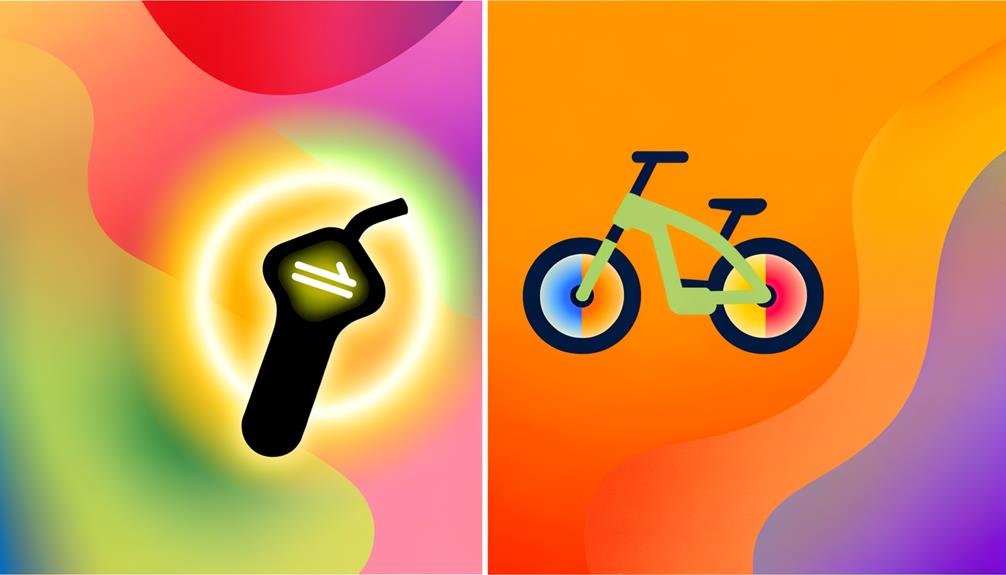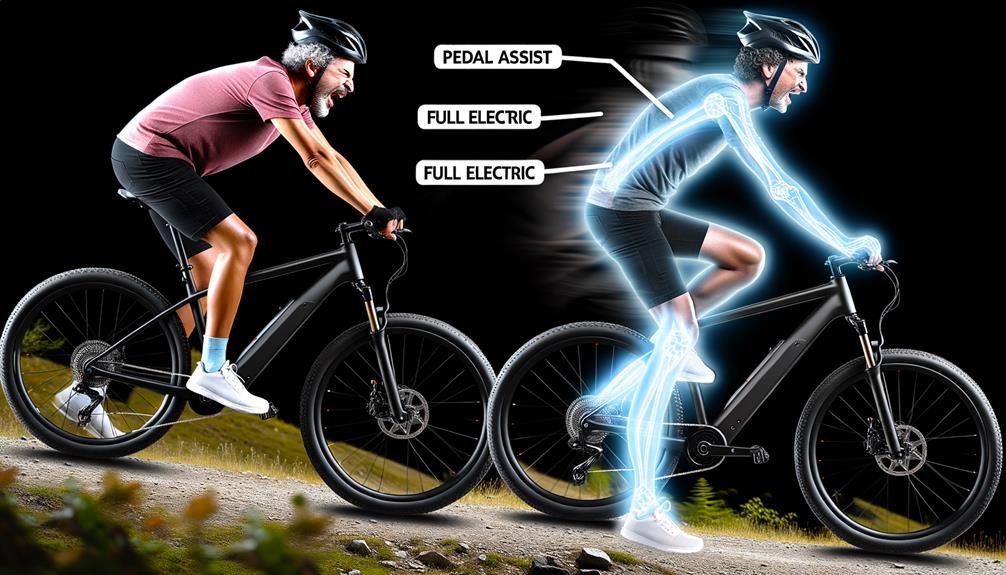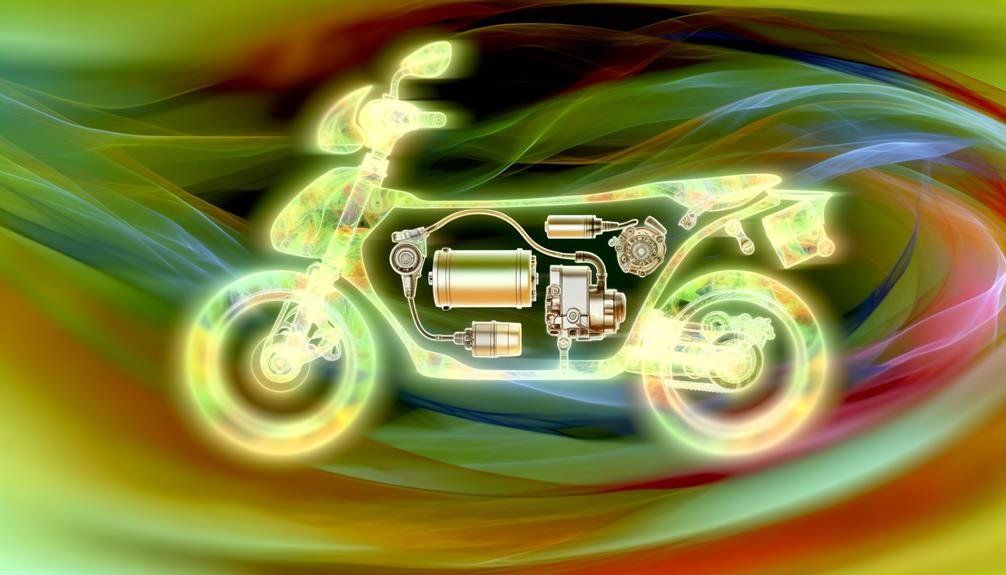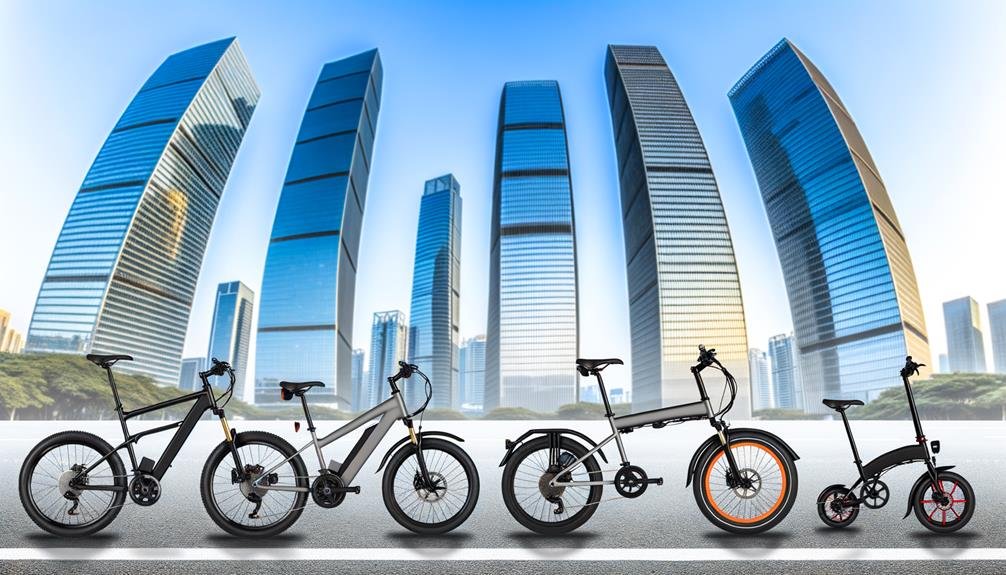Charles Miller is a veteran bike enthusiast with over 12 years of experience dealing with bikes as a mechanic. Despite immense love and expertise for...
You might think that pedaling an electric bike is as easy as riding a cloud, but the reality is a bit more grounded. While the electric motor does offer assistance, making the bike easier to pedal than a traditional bicycle, the amount of effort required can vary greatly.
Factors such as the bike's weight, the terrain, and the level of pedal assist you choose to use can all impact the difficulty. To fully understand the dynamics of pedaling an electric bike, you'll need to dive deeper into the intricacies of e-bike mechanics.
- Key Takeaways
- Understanding Electric Bike Mechanics
- Debunking Electric Bike Myths
- Pedaling Effort in E-bikes
- Usage Purpose and E-bikes
- Comfort With Heavier Bikes
- Importance of E-bike Practice
- Pedal Assist Vs. Throttle
- Riding an E-bike: Guidelines
- E-bikes: Pedal Modes Explained
- E-bike Motor Functionality
- Frequently Asked Questions
- Conclusion
Key Takeaways
- The difficulty of pedaling an electric bike is influenced by factors such as bike weight, terrain, pedal assist level, and the rider's fitness level.
- Contrary to popular belief, pedaling an electric bike can be smooth and easy with a full charge and the right pedal assist option.
- Regular practice and familiarity with the e-bike can reduce the effort required for pedaling.
- Different types of e-bikes have unique power delivery and pedaling modes, allowing riders to choose the level of physical effort they want to exert.
Understanding Electric Bike Mechanics
While different types of electric bikes offer various pedal assist options like throttle, pedal assist, and twist and go, it's important to note that the weight of these bikes can significantly increase the difficulty of pedaling, particularly on steep terrains. As an enthusiast, you need to comprehend the mechanics of your e-bike. The added weight, derived from the battery and motor, could make your ride more strenuous, even with pedal assist.
Your bike's purpose, be it leisure, adventure, or commuting, also impacts your pedaling ease. For instance, a leisurely ride in the park wouldn't pose as much difficulty as a steep uphill trail. Electric bikes are heavier than regular ones, and this is where your fitness level comes into play. Wearing appropriate biking gear can help alleviate some of the strain.
As with any new skill, practice is crucial. Regularly riding your electric bike will help you adapt to its weight and pedaling dynamics, making it easier to pedal over time. Remember, mastering the mechanics of your electric bike isn't just about the ride; it's also about being part of a community that shares your passion for e-bikes.
Debunking Electric Bike Myths
Shifting gears from understanding the mechanics of electric bikes, let's debunk some prevalent myths surrounding them, particularly concerning pedaling and ride quality. It's essential to dispel these misconceptions to appreciate the value of a Pedal Bike fully.
Here are five debunked electric bike myths:
- You're not confined to a single pedaling mode. Electric bikes offer diverse options, including throttle-only, pedal assist, and twist and go.
- Yes, electric bikes are heavier, but that doesn't mean it's harder to pedal. With a full charge, it's quite a smooth ride.
- Flat pavement commuting isn't a Herculean task on an electric bike. You'll find it's just as effortless, if not more so, than with a traditional bicycle.
- It takes some getting used to, but with consistent practice, you'll find pedaling an electric bike easier than a regular one.
- Electric bikes may reach higher speeds, but starting at a low assistance level will help you adjust comfortably.
Pedaling Effort in E-bikes

You'll find that pedaling effort in e-bikes is determined by a complex interplay between several factors.
Firstly, grasp the mechanics of e-bikes, especially the differences in Class 1, 2, and 3 models, and how they influence pedaling difficulty.
Then, consider how you can reduce this effort, noting the impact of weight, bike setup, and motor type, as well as the importance of a full battery charge and regular practice.
Understanding E-bike Mechanics
In understanding the mechanics of e-bikes, it's critical to note the pedaling effort required, which can vary based on the bike's weight, its charge level, and the type of motor and pedal assist options it offers.
Consider these key aspects:
- E-bikes come with different pedal assist options. You can choose from throttle, pedal assist, or manual modes.
- The bike's weight can make pedaling an electric bike more challenging.
- When your bike has a full charge, the pedaling process becomes less complicated.
- The purpose of your bike matters. Riding up steep paths on an e-bike can be more difficult.
- Different e-bike models and electric motor types offer varying levels of resistance when pedaling without power. Practice is essential to get comfortable with the weight and feeling of pedaling with the motor.
E-bike Pedaling Difficulty
When pedaling an e-bike, it's not just about the ride; the type of pedaling mode you choose, the bike's weight, battery charge status, and the purpose of your ride all play a substantial role in the pedaling difficulty.
The e-bike pedaling difficulty can increase with the weight of the bike, especially on steep paths. However, riding with a full battery can make pedaling an electric bike less strenuous.
Your purpose, whether it's leisure, adventure, or commuting, can also impact the effort needed to pedal. Regular practice can help you get used to the weight and pedaling effort, enhancing your comfort and control.
Lastly, remember, proper care and maintenance of your e-bike can significantly improve its performance and reduce the pedaling difficulty.
Reducing Effort With E-Bikes
Despite the increased effort needed to manage the weight and pedaling dynamics of e-bikes, technological advancements like pedal-assist and throttle features significantly reduce the physical exertion required for pedaling. Reducing effort with e-bikes is no longer a dream, but a reality.
Here are some key ways how e-bikes make pedaling less effort:
- Pedal-assist e-bikes activate the motor as you pedal, decreasing your physical effort.
- Throttle-equipped e-bikes let you ride without the need to pedal.
- Class 2 e-bikes have a throttle, reducing the necessity for pedaling.
Although e-bikes are heavier, getting used to the weight and pedaling dynamics can make it easier. Regular practice and familiarity with your e-bike will eventually require less effort for pedaling.
Usage Purpose and E-bikes

E-bikes, often used for commuting, leisure, and even fitness, provide you with the versatility to tackle both steep and flat paths, making your ride enjoyable and less strenuous. They're perfect for longer distances, allowing you to cover more ground with less effort. This fitness-friendly feature makes the usage purpose and e-bikes symbiotic.
You'll find different types of e-bikes, each with unique power delivery systems and pedaling modes. The table below illustrates the options:
| E-Bike Type | Power Delivery | Pedaling Mode |
|---|---|---|
| Type 1 | Manual | You pedal an electric bike |
| Type 2 | Eco-mode | Assists you, but requires pedaling |
| Type 3 | Auto mode | Fully motor-powered, no pedaling needed |
The motor can be turned off if you prefer to pedal without assistance. This feature gives you a good workout, considering the heavier weight of the bike. However, the versatility of e-bikes extends beyond the ride itself. They're practical for carrying items like laptops or groceries, adding another layer of convenience to your commute. As you can see, the usage purpose and e-bikes go hand in hand, making them a valuable tool for the modern cyclist.
Comfort With Heavier Bikes
As you approach the task of pedaling an electric bike, it's essential to consider your comfort with handling the extra weight.
This added heft can impact your cycling speed and may introduce new stability concerns.
You'll need to assess and adapt to these challenges for a smooth, enjoyable e-biking experience.
Handling the Extra Weight
When first transitioning to electric bikes, you'll need to get accustomed to managing the additional weight these bikes typically carry. Remember, these bikes are heavier and handling the extra weight might feel challenging initially.
Here are five strategies to make the transition smoother:
- Start by practicing on flat terrain before moving to hilly areas.
- Maintain a firm grip on the handlebars to ensure stability.
- Consider using lower gear ratios to make pedaling easier.
- Gradually increase the duration of your rides to build endurance.
- Always perform a quick check on the bike's tires and brakes before each ride.
With time and practice, you'll feel more comfortable with the extra weight, making your e-bike rides enjoyable and effortless.
Effect on Cycling Speed
Having mastered the handling of the extra weight from your electric bike, let's now consider how this added mass might impact your cycling speed and overall comfort during rides.
When you ride an electric bike, the additional weight can make pedaling more challenging, especially uphill, having a tangible effect on cycling speed. This directly impacts your riding experience. It's also worth noting that the effort required to overcome this weight varies depending on your individual fitness level.
Therefore, choosing an electric bike that aligns with your comfort level and pedaling preferences becomes paramount. Being comfortable with a heavier bike can enhance your ability to maintain speed and enjoy your ride, making the cycling experience less strenuous and more enjoyable.
Stability Concerns With Heaviness
Despite the benefits of electric biking, it's essential to note that the increased weight of these bikes can pose stability concerns, particularly if you're not accustomed to handling heavier bicycles. Here are some points to consider:
- Heavier electric bikes may require more effort to pedal, especially when not using the motor. That's where your energy comes into play.
- Comfort with the weight of an electric bike is crucial for stability. It's a different beast from a traditional bike.
- You might sweat more due to the extra 42 pounds on an electric bike. Stay hydrated!
- Ensure your bike fits you properly. Adjustments can enhance comfort and control.
- Practice makes perfect. Familiarize yourself with the balance of the bike for a smoother ride.
Importance of E-bike Practice
To truly master the art of riding an electric bike, the importance of regular practice – both with and without the battery assistance – can't be overstated. Practice is vital to build comfort and capability while adapting to the bike's weight and pedaling rhythm with the motor. This familiarity gained through consistent e-bike practice significantly enhances your overall riding experience.
Being comfortable with the weight of the electric bike is a significant aspect of mastering the ride. Different scenarios require different riding skills, and practice is the key to developing these skills. Through consistent practice, you learn to maneuver the bike's weight, improving your control and confidence.
The importance of e-bike practice also lies in the transition from pedaling with motor assistance to without. This shift can be challenging initially, but with regular practice, it becomes second nature. Eventually, pedaling an electric bike becomes easier than a regular bike.
In essence, practice not only enhances your comfort and control but also enriches your overall e-bike riding experience. So, don't underestimate the importance of e-bike practice – it's the key to unlocking your full potential on the electric bike.
Pedal Assist Vs. Throttle

As you explore e-bike mechanisms, consider the difference between pedal assist and throttle.
Pedal assist bikes activate the motor with each pedal stroke, providing a boost to your efforts.
On the other hand, Class 2, or 'twist and go' bikes, feature a throttle that propels the bike forward without any need for pedaling.
Understanding Pedal Assist
When you're considering an electric bike, it's crucial to understand the difference between pedal assist and throttle modes, as they significantly alter the riding experience.
Understanding pedal assist is key to enjoying your ride. Here are some key differences:
- Pedal assist bikes, or pedelecs, activate the motor only when you pedal. This offers a more natural, integrated riding experience.
- Class 1 and Class 3 pedal electric bikes are equipped with pedal assist, while Class 2 bikes use a throttle, like a motorcycle.
- Pedal assist promotes a more engaging, efficient ride by seamlessly integrating motor power as you pedal.
In contrast, throttle-based electric bikes enable you to ride without pedaling.
Understanding these differences can help you choose the right electric bike for your personal preferences and riding style.
Exploring Throttle Mechanism
Let's dive into the throttle mechanism of electric bikes, a feature that allows you to ride without pedaling, quite similar to how a motorcycle operates.
This exploring throttle mechanism journey brings us to Class 2 pedal electric bikes, often known as 'twist and go' bikes. Unlike Class 1 and Class 3 bikes, which rely on pedal assist, these bikes are equipped with a throttle.
Your choice between pedal assist and throttle largely depends on your biking purpose – leisure, adventure, or commuting.
And remember, it's important to familiarize yourself with riding an electric bike. Practice with and without the battery's assistance and get comfortable with the weight and feel of pedaling with the motor.
Riding an E-bike: Guidelines
Navigating the world of electric bikes involves understanding the different types, pedaling options, and class distinctions they offer. When it comes to riding an e-bike, several guidelines can help you get the most out of your experience.
Here are some key pointers:
- Know your bike type and pedaling options: There are various e-bikes like throttle and pedal-assist bikes, each with its unique features.
- Factor in the pedaling effort: E-bikes are heavier than standard bikes. However, a fully charged bike eases pedaling.
- Consider your purpose: If you're riding up steep paths, proper charging is crucial.
- Match your fitness level: Ensure you can comfortably handle the bike's weight and the effort required while pedaling.
- Understand the pedaling modes: E-bikes come with different power delivery systems. Start with a low assistance level to gradually get accustomed to the riding experience.
E-bikes: Pedal Modes Explained

Understanding the various pedal modes on an e-bike, which include throttle, pedal assist, and manual power levels, is crucial for optimizing your riding experience.
The throttle mode, common in Class 2 e-bikes, lets you move without pedaling, making your e-bike essentially a pedal electric scooter.
Class 1 and 3 e-bikes, on the other hand, activate the electric motor when you pedal, offering different levels of assistance.
In pedal assist mode, the e-bike's motor provides assistance only when you're pedaling. The level of assistance varies, allowing you to customize your ride experience based on your energy level and the terrain.
In contrast, manual power mode requires pure human effort, much like traditional bikes. This mode can be more challenging due to the e-bike's weight, especially when the battery charge is low.
The key to mastering e-bike pedaling lies in practice and familiarity with the weight and motor performance. It's worth noting that different pedal modes and power levels significantly impact how hard it's to pedal an e-bike. Therefore, understanding and adjusting these settings according to your needs is vital for a seamless and enjoyable ride.
E-bike Motor Functionality
Now that you've grasped the nuances of pedaling an e-bike, it's important to explore the engine that powers this innovative vehicle – the e-bike motor. Understanding the e-bike motor functionality can enhance your pedal electric experience. The motor, battery, and controller harmoniously work together to provide you with pedal assistance, making your ride smoother and less strenuous.
Here's a simple breakdown of how it works:
- The motor draws power from the battery, giving a boost to the back wheel when you pedal.
- E-bikes offer various pedaling modes, such as Eco, Manual, and Auto, giving you control over the level of assistance.
- You have the option to turn off the motor, allowing you to pedal without assistance for a more traditional biking experience.
- Different e-bike motor models like Bosch, Shimano, Brose, and Yamaha offer varying levels of resistance when pedaling without power.
Frequently Asked Questions
Is an Electric Bike Harder to Pedal?
Yes, you'll find more pedal resistance in an electric bike due to its weight. However, its energy efficiency makes pedaling easier when you're using pedal assist modes. It's all about getting used to it.
Is It Difficult to Ride an Electric Bike?
Pedaling an electric bike isn't hard. You'll acclimate to its weight and assist features. Remember, your e-bike maintenance and electric bike safety are key. Ride frequently, learn its nuances, and you'll be cruising comfortably soon.
Can a Beginner Ride an Electric Bike?
As a beginner, you'll find comfort in an electric bike's user-friendly nature. With proper safety measures, like starting on a flat area and familiarizing yourself with the brakes, you'll be riding confidently in no time.
Can You Just Pedal an Electric Bike?
Yes, you can just pedal an electric bike. Pedal resistance varies, and the battery's impact can make pedaling easier. However, it'll feel heavier than a regular bike, especially if the battery's drained.
Conclusion
So, you've cranked through the gears of understanding electric bike mechanics, debunked some myths, and considered pedaling efforts.
Remember, choosing an e-bike should hinge on your purpose and comfort level. It's not rocket science, but the right balance between pedal assist and throttle.
Tune into your e-bike's motor functionality to maximize your ride. As you saddle up and charge forth, remember, this ain't your grandpa's Oldsmobile. It's high-tech, it's savvy, and it's all about making your ride smoother.

Charles Miller is a veteran bike enthusiast with over 12 years of experience dealing with bikes as a mechanic. Despite immense love and expertise for his Tacoma, he rides his Trek Ebike more. Anytime you meet him, you’ll either hear him talking about Bikes, or writing about all things bikes and cars on this blog.
More Posts


